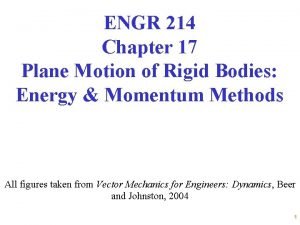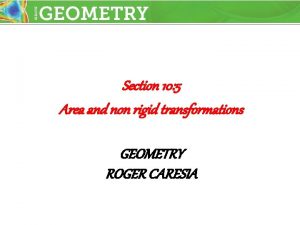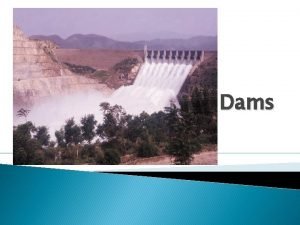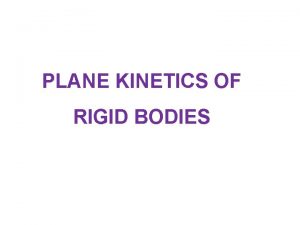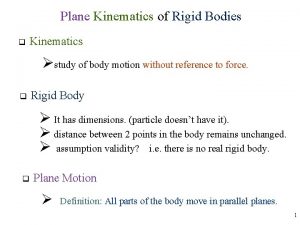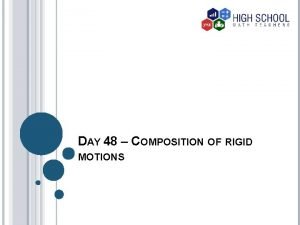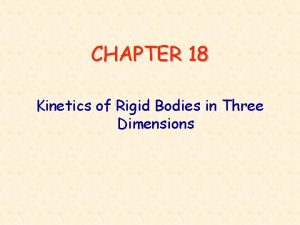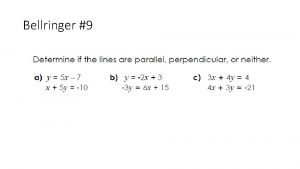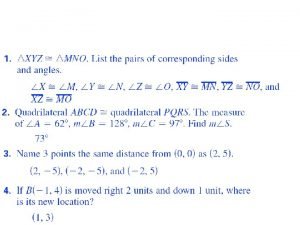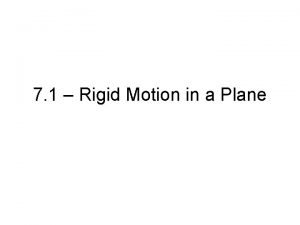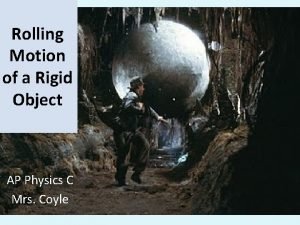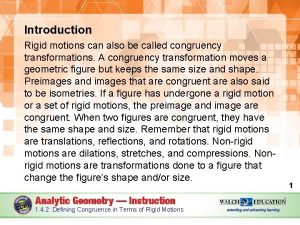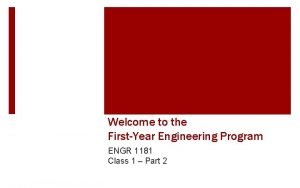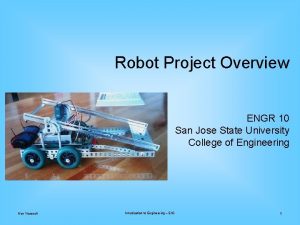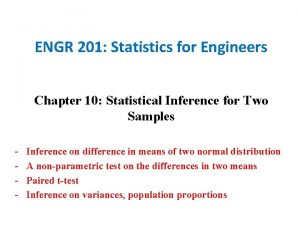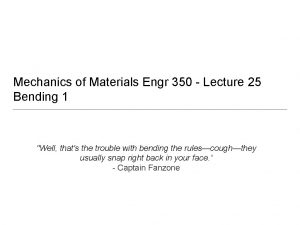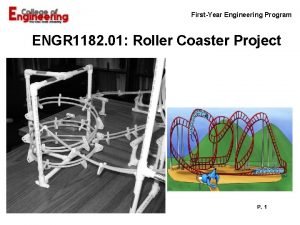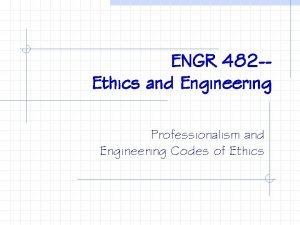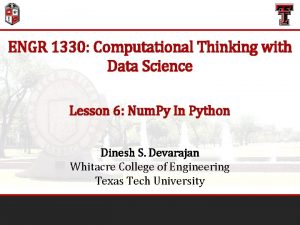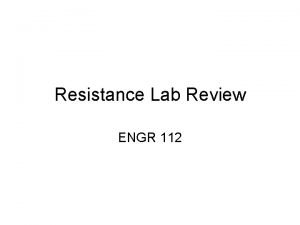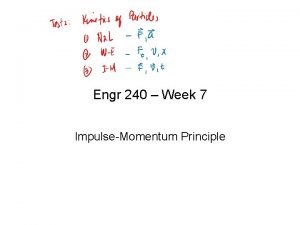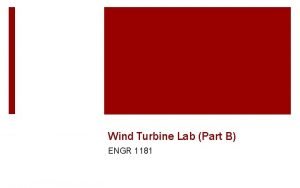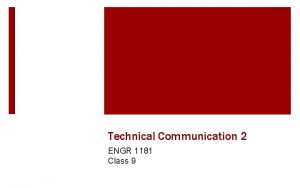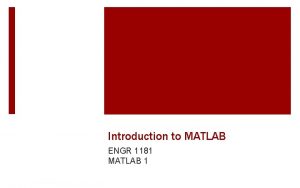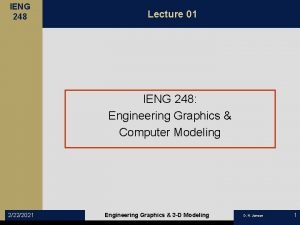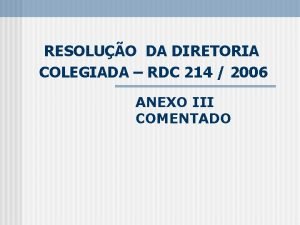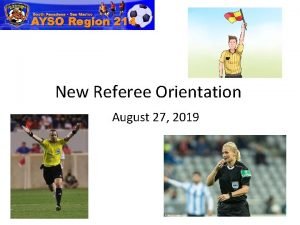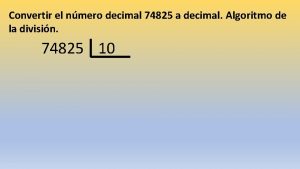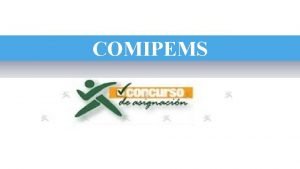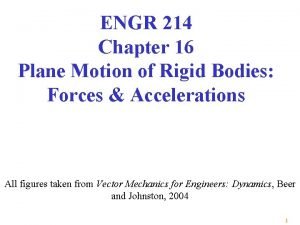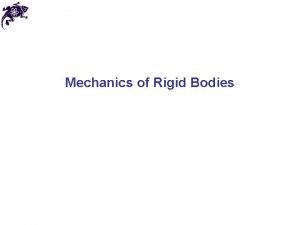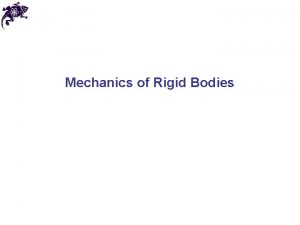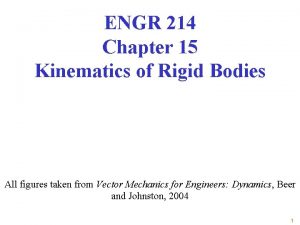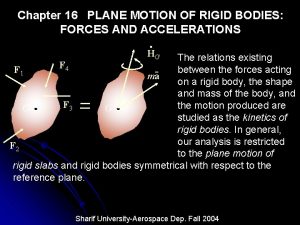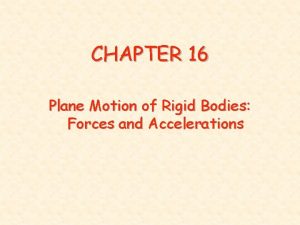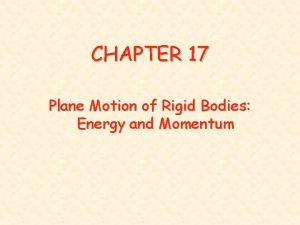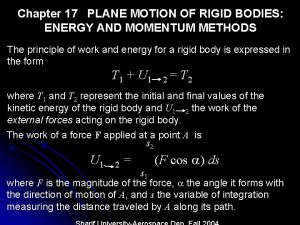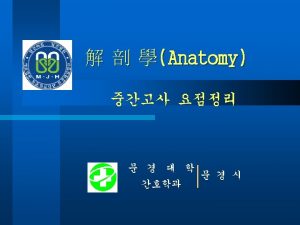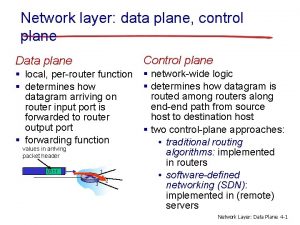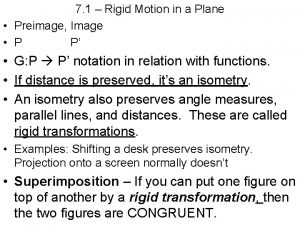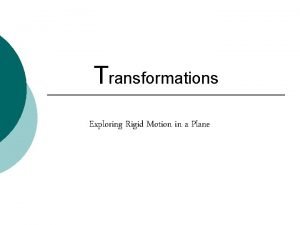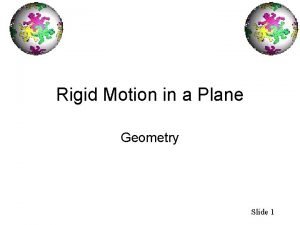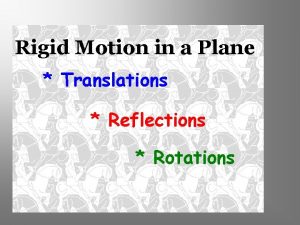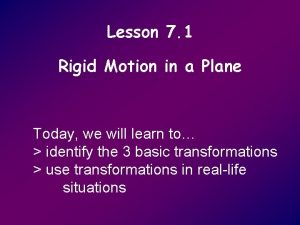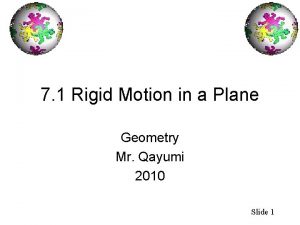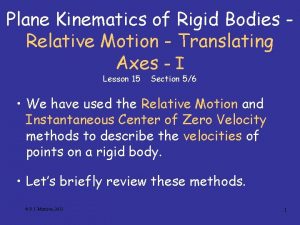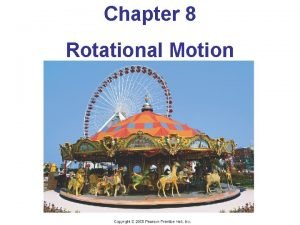ENGR 214 Chapter 17 Plane Motion of Rigid










































- Slides: 42

ENGR 214 Chapter 17 Plane Motion of Rigid Bodies: Energy & Momentum Methods All figures taken from Vector Mechanics for Engineers: Dynamics, Beer and Johnston, 2004 1

Principle of Work and Energy for a Rigid Body initial and final total kinetic energy of rigid body total work of external forces acting rigid body Work done: For a couple: If M is constant: 2

Kinetic Energy of a Rigid Body in Plane Motion Plane motion combination of translation & rotation G G v. G For non-centroidal rotation: 3

Principle of Work and Energy: System of Rigid Bodies Can be applied to each body separately or to the system as a whole sum of kinetic energies of all bodies in system work of all external forces acting on system Useful in problems involving several bodies connected together by pins, inextensible chords, etc. because internal forces do no work & reduces to the work of external forces only. 4

Conservation of Energy Example: rod is released with zero velocity from horizontal position. Determine angular velocity after rod has rotated q. 0. 5 l 5

6

Power = rate at which work is done For a rotating body: 7

Sample Problem 17. 1 A 240 -lb block is suspended from an inextensible cable which is wrapped around a drum of 1. 25 -ft radius attached to a flywheel. The drum and flywheel have a combined moment of inertia I=10. 5 lb ft s 2. At the instant shown, the velocity of the block is 6 ft/s downward. Knowing that the bearing friction is equivalent to a couple of magnitude 60 lb ft, determine the velocity of the block after it has moved 4 ft downward. 8

Sample Problem 17. 1 with 9

Sample Problem 17. 2 The system is at rest when a moment M=6 Nm is applied to gear B. Neglecting friction, a) determine the number of revolutions of gear B before its angular velocity reaches 600 rpm, and b) tangential force exerted by gear B on gear A. 10

Sample Problem 17. 2 But 11

Sample Problem 17. 2 For gear A: 12

Sample Problem 17. 3 A sphere, cylinder, and hoop, each having the same mass and radius, are released from rest on an incline. Determine the velocity of each body after it has rolled through a distance corresponding to a change of elevation h. 13

Sample Problem 17. 3 Friction force in rolling does no work 14

Sample Problem 17. 3 • Each of the bodies has a different centroidal moment of inertia, NOTE: • For a frictionless block sliding through the same distance, 15

Can also be solved using conservation of energy: 16

Sample Problem 17. 4, SI units 1. 524 m 0. 305 m A 13. 608 -kg slender rod pivots about the point O. The other end is pressed against a spring (k = 315. 212 k. N/m) until the spring is compressed 25. 4 mm and the rod is in a horizontal position. If the rod is released from this position, determine its angular velocity and the reactions at the pivot as the rod passes through a vertical position. 17

Sample Problem 17. 4 18

Sample Problem 17. 4 To get pin reactions: W 19

Sample Problem 17. 5 Each of the two slender rods has a mass of 6 kg. The system is released from rest with b = 60 o. Determine a) the angular velocity of rod AB when b = 20 o, and b) the velocity of the point D at the same instant. 20

Sample Problem 17. 5 SOLUTION: • Consider a system consisting of the two rods. With the conservative weight force, • Evaluate the initial and final potential energy. 21

Sample Problem 17. 5 • Express the final kinetic energy of the system in terms of the angular velocities of the rods. Since is perpendicular to AB and is horizontal, the instantaneous center of rotation for rod BD is C. and applying the law of cosines to CDE, EC = 0. 522 m Consider the velocity of point B For the final kinetic energy, 22

Sample Problem 17. 5 • Solve the energy equation for the angular velocity, then evaluate the velocity of the point D. 23

Principle of Impulse and Momentum For a rigid body in general plane motion: Can be split into 2 components (x and y) 24

Principle of Impulse and Momentum For non-centroidal rotation 25

Conservation of Angular Momentum • When no external force acts on a rigid body or a system of rigid bodies, the system of momenta at t 1 is equipollent to the system at t 2. The total linear momentum and angular momentum about any point are conserved, • When the sum of the angular impulses pass through O, the linear momentum may not be conserved, yet the angular momentum about O is conserved, • Two additional equations may be written by summing x and y components of momenta and may be used to determine two unknown linear impulses, such as the impulses of the reaction components at a fixed point. 26

Sample Problem 17. 6 The system is at rest when a moment M=6 Nm is applied to gear B. Neglecting friction, a) determine the time required for the angular velocity of gear B to reach 600 rpm, and b) tangential force exerted by gear B on gear A. 27

Sample Problem 17. 6 Gear A: Gear B: Solving yields: 28

Sample Problem 17. 7 A uniform sphere of mass m and radius r is projected along a rough horizontal surface with a linear velocity and no angular velocity. The coefficient of kinetic friction is Determine a) the time t 2 at which the sphere will start rolling without sliding and b) the linear and angular velocities of the sphere at time t 2. 29

Sample Problem 17. 7 rolling Along x: Rotation about G: Solving: 30

Sample Problem 17. 8 SOLUTION: • Observing that none of the external forces produce a moment about the y axis, the angular momentum is conserved. Two solid spheres (radius = 3 in. , W = 2 lb) are mounted on a spinning horizontal rod ( w = 6 rad/sec) as shown. The balls are held together by a string which is suddenly cut. Determine a) angular velocity of the rod after the balls have moved to A’ and B’, and b) the energy lost due to the plastic impact of the spheres and stops. • Equate the initial and final angular momenta. Solve for the final angular velocity. • The energy lost due to the plastic impact is equal to the change in kinetic energy of the system. 31

Sample Problem 17. 8 Sys Momenta 1 + Sys Ext Imp 1 -2 = Sys Momenta 2 SOLUTION: • Observing that none of the external forces produce a moment about the y axis, the angular momentum is conserved. • Equate the initial and final angular momenta. Solve for the final angular velocity. 32

Sample Problem 17. 8 • The energy lost due to the plastic impact is equal to the change in kinetic energy of the system. 33

Eccentric Impact Period of deformation Period of restitution As for particles: Same relation applies for rigid bodies Note: velocities are along line of impact 34

Eccentric Impact If one or both of the colliding bodies rotates about a fixed point O, an impulsive reaction will develop 35

Sample Problem 17. 9 A 0. 05 -lb bullet is fired with a horizontal velocity of 1500 ft/s into the side of a 20 -lb square panel which is initially at rest. Determine a) the angular velocity of the panel immediately after the bullet becomes embedded and b) the impulsive reaction at A, assuming that the bullet becomes embedded in 0. 0006 s. 36

Sample Problem 17. 9 Impulse & momentum: For entire system: x components: Moments about A: b y components: Then: but Solving: 37

Sample Problem 17. 10 A 2 -kg sphere with an initial velocity of 5 m/s strikes the lower end of an 8 -kg rod AB. The rod is hinged at A and initially at rest. The coefficient of restitution between the rod and sphere is 0. 8. Determine the angular velocity of the rod and the velocity of the sphere immediately after impact. 38

Sample Problem 17. 10 Impulse & momentum: Moments about A: where + Solving: 39

Sample Problem 17. 11 A square package of mass m moves down conveyor belt A with constant velocity. At the end of the conveyor, the corner of the package strikes a rigid support at B. The impact is perfectly plastic. Derive an expression for the minimum velocity of conveyor belt A for which the package will rotate about B and reach conveyor belt C. 40

Sample Problem 17. 11 • Apply principle of impulse and momentum at impact (just before & just after impact) Moments about B: 41

Sample Problem 17. 11 • Apply principle of conservation of energy (just after impact until maximum height) (solving for the minimum w 2) 42
 Plane motion of rigid bodies: energy and momentum methods
Plane motion of rigid bodies: energy and momentum methods Data plane control plane and management plane
Data plane control plane and management plane Rigid vs non rigid transformations
Rigid vs non rigid transformations Overflow and non overflow dams
Overflow and non overflow dams What is rigid and non rigid
What is rigid and non rigid Rigid body kinetics
Rigid body kinetics Iczv
Iczv Center of mass of a rigid body
Center of mass of a rigid body Rigid motion
Rigid motion Rigid body kinetics
Rigid body kinetics Rigid motion definition
Rigid motion definition Rigid motion in geometry
Rigid motion in geometry Is a dilation a rigid motion?
Is a dilation a rigid motion? Rolling motion of a rigid object
Rolling motion of a rigid object Introduction rigid motion or isometry
Introduction rigid motion or isometry Engineering 1181
Engineering 1181 Sjsu engineering 10
Sjsu engineering 10 Engr 201
Engr 201 Engr 1182
Engr 1182 Engr 350
Engr 350 Performance task: roller coaster design
Performance task: roller coaster design Engr 482
Engr 482 Engr 1330
Engr 1330 Engr 1330 ttu
Engr 1330 ttu Engr 112
Engr 112 Engr 240
Engr 240 Engr 10 sjsu
Engr 10 sjsu Engr 1181
Engr 1181 Upute za izradu plakata
Upute za izradu plakata Unr cse
Unr cse Engr 1181
Engr 1181 Engr 1181
Engr 1181 Engr 248
Engr 248 Chapter 2 section 1 describing motion answer key
Chapter 2 section 1 describing motion answer key Describing and measuring motion
Describing and measuring motion Section 1 describing motion
Section 1 describing motion Rdc 214 de 2006
Rdc 214 de 2006 Ayso214
Ayso214 Happy 214
Happy 214 In the time of the butterflies chapter 9
In the time of the butterflies chapter 9 214 en binario
214 en binario Escuela secundaria 214
Escuela secundaria 214 Ntp montacargas
Ntp montacargas
